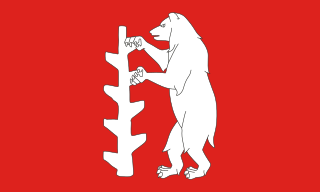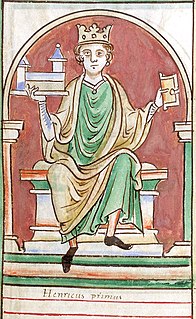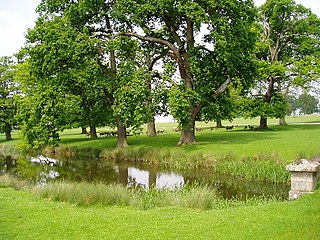A hundred is an administrative division that is geographically part of a larger region. It was formerly used in England, Wales, some parts of the United States, Denmark, Southern Schleswig, Sweden, Finland, Estonia, and Norway. It is still used in other places, including South Australia, and The Northern Territory.

Withington is a suburb of south Manchester, England. Historically part of Lancashire, it lies 4 miles (6.4 km) from Manchester city centre, about 0.4 miles (0.6 km) south of Fallowfield, 0.5 miles (0.8 km) north-east of Didsbury and 1 mile (1.6 km) east of Chorlton-cum-Hardy. Withington has a population of just over 14,000 people, reducing at the 2011 census to 13,422.

Baddesley Clinton is a moated manor house, situated about 8 miles north-west of the town of Warwick in Warwickshire, England. The house probably originated in the 13th century, when large areas of the Forest of Arden were cleared for farmland. The site is a Scheduled Ancient Monument and the house is a Grade I listed building.
The Inclosure Acts were a series of Acts of Parliament that empowered enclosure of open fields and common land in England and Wales, creating legal property rights to land that was previously held in common. Between 1604 and 1914, over 5,200 individual enclosure acts were passed, covering 6.8 million acres.
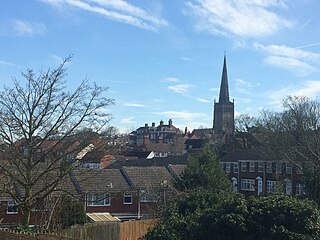
Coleshill is a market town in the North Warwickshire district of Warwickshire, England, taking its name from the River Cole, which it stands on. It had a population of 6,481 in the 2011 census and is situated 11 miles (18 km) east of Birmingham.
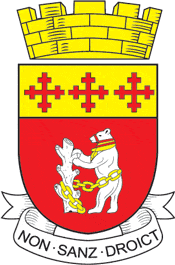
This is about the history of the county Warwickshire situated in the English Midlands. Historically, bounded to the north-west by Staffordshire, by Leicestershire to the north-east, Northamptonshire to the east, Worcestershire to the west, Oxfordshire to the south and Gloucestershire to the south-west. Areas historically part of Warwickshire include Coventry, Solihull, Sutton Coldfield and a small area of central Birmingham including Aston and Edgbaston. These became part of the metropolitan county of West Midlands following local government re-organisation in 1974 after the passage of the Local Government Act 1972.

Bordesley is an area of Birmingham, England, 1.2 miles (2 km) to the south east of the city centre, in the southern part of the City's Nechells ward. It is the real life setting of the BBC series Peaky Blinders, and home to Birmingham City F.C.'s ground, St Andrew's. It should not be confused with nearby Bordesley Green.

Appleby Magna is a village and civil parish in Leicestershire, England. It includes the small hamlets of Appleby Parva and Little Wigston, and the villages of Norton-Juxta-Twycross, Snarestone and Swepstone. The parish has a total collective population of 1,084 (2011), with Appleby its largest settlement. Historically, Appleby was one of the largest and wealthiest parishes in Leicestershire, which was reflected by its large church. However, the village and its population have remained fairly small.

Bickenhill is a village in the civil parish of Bickenhill and Marston Green, in the Solihull district, in the county of the West Midlands, England, on the eastern fringe of the West Midlands conurbation. Bickenhill is home to Birmingham Airport. Bickenhill is also a ward. It is in the historic county of Warwickshire.

Compton Verney is a parish and historic manor in the county of Warwickshire, England. The population taken at the 2011 census was 119. The surviving manor house is the Georgian mansion Compton Verney House.

Chingle Hall is a grade II listed manor house in the township of Whittingham near Preston, England.

Nether Whitacre is a small village and larger rural civil parish in North Warwickshire, Warwickshire, England.
Langley Hall was a manor house just off Fox Hollies Road, one mile from the centre of Walmley in Sutton Coldfield in the historic county of Warwickshire.
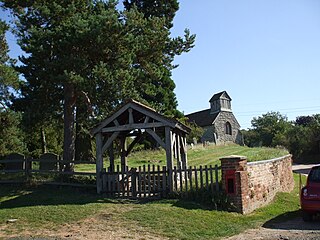
Morton Bagot is a small village in the Stratford-on-Avon district of Warwickshire, England. The population from the 2011 Census is included within Redditch(Worcs). It lies about 1.5 miles (2 km) east of the Birmingham-Alcester road, the modern A435 and Roman Ryknild Street, 6.5 miles (10 km) north of Alcester, 9.5 miles (15 km) from Stratford upon Avon and 12 miles from Warwick, across the valley of a small brook, flowing south-east to join the River Arrow. A road from Oldberrow to Spernall runs north and south through the middle of the parish of Morton Bagot, Oldberrow and Spernall, past the church. The name means the settlement of the moor, the Bagot element coming from the name of the lords of the Manor who added their name when they came into possession during the reign of Henry II.

Feckenham Forest was a royal forest, centred on the village of Feckenham, covering large parts of west Worcestershire and Warwickshire. It was not entirely wooded, nor entirely the property of the King. Rather, the King had legal rights over game, wood and grazing within the forest, and special courts imposed harsh penalties when these rights were violated. Courts and the forest gaol were located at Feckenham and executions took place at Gallows Green near Hanbury.

Idlicote is a small settlement and civil parish in the English county of Warwickshire, about 3 miles (5 km) north-east of Shipston-on-Stour and 8 miles (13 km) south-east of Stratford-on-Avon. Population details can be found under Honington, Warwickshire.

Moreteyne Manor (previously known as Moat Farmhouse} is a 15th-century manor house in Marston Moretaine, Bedfordshire, England. For many years it was used as a farmhouse but is now a country house restaurant. It is a Grade II* listed building.
